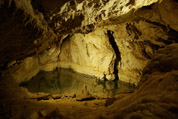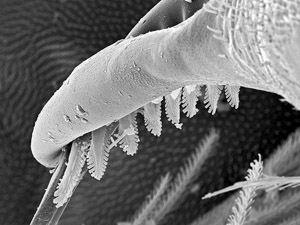 |
Slovak Arachnological Society |
|
Palpigradi (microwhip scorpions) |
|
|
Araneae • Opiliones • Pseudoscorpiones • Palpigradi • Schizomida • Acari |
|
 |
Slovak Arachnological Society |
|
Palpigradi (microwhip scorpions) |
|
|
Araneae • Opiliones • Pseudoscorpiones • Palpigradi • Schizomida • Acari |
|
Microwhip scorpions (Palpigradi) are diminutive and blind arachnids, living cryptic lives in warm countries, and unknown or unnoticed by nearly all men.
Palpigrades are enigmatic arachnids with numerous ancestral character states, e.g. three-segmented chelicerae, segmented prosoma, leg-like pedipalps, antenniform first legs and a multisegmented
whip-like flagellum (Condé 1996). As in some other arachnids, the first pair of legs is
modified to serve as sensory organs. Palpigrades occur in many different climate from tropical and sub-tropical
rainforests (they live primarily in tropical soils) to subterranean environments in central Europe and arid Australia (Harvey 2013).
In Slovakia, two species from the genus Eukoenenia were found.
|
|
Eukoenenia spelaea from Ardovská Cave, © Ľubomír Kováč & Vladimír Kóňa |
|
did you know... |
 |
Palpigrades from Slovak caves. The Demänová Cave system (Low Tatras) and Važecká Cave (Kozie chrbty Mts.) are the northernmost known localities for entire Palpigradida group (latitude of roughly 49° N). The discovery of these animals in these caves confirms the hypothesis that Pleistocene mountain glaciation in Central Europe did not completely extinguish local subterranean fauna. |
 |
Eukoenenia spelaea as vegetarian? Single-celled cyanobacteria (blue-green algae) were conspicuously predominant in the gut of all studied palpigrades from Ardovská Cave in Slovakia. Their chelicerae as a whole looks more like a comb or brush than the forceps of a predator. Their flat teeth are fringed or flanked by small marginal teeth (Smrž et al. 2013). |
 |
Holy home of microwhip scorpions. A palpigrade specimens belonging to Eukoenenia austriaca-complex was extracted from bottom substrate in the catacombs of the St. Stephen's Cathedral in Vienna. The specimen found in Vienna catacombs comes from Pleistocene Danube gravel mixed with moist fine-grained material and anthropogenic debris. It suggests Palpigrades as component of interstitial fauna in Central Europe (Christian 1998). |
|
external links |
|
International Society of Arachnology |
|
|
 Editor:
Peter Fenďa & Ľubomír Kováč Editor:
Peter Fenďa & Ľubomír Kováč |
| Last updated: 16th November 2018 |
|
|